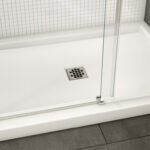Last updated on February 28th, 2024 at 02:11 am
Estimating how much paint you’ll need is a very important part of the painting. Knowing how to measure and estimate before you start will save time, money, and potential frustration.
This blog post will provide some tips on measuring and estimating for painting your home or commercial space.
The first step of painting is to measure and estimate the amount of paint needed. This is done by measuring the width, height, and length of a wall. Next, you will need to divide these measurements by the number of coats that are desired.
For example, if you want two coats applied then you would multiply them together for an answer of 2x2x2=8. You can use this same process with any surface or space that needs to be painted in order to determine how much paint is required beforehand so there are no surprises when it’s time to head out to buy supplies!
How Does a Quantity Surveyor Helps to Calculate Painting?
Quantity surveying is the process of producing cost estimates for construction projects, usually based on a bill of quantities prepared by an architect or engineer.
The final cost estimate produced by a quantity surveyor takes into account allowances for fees, overheads, and profit. Lump sums are often used in the early stages of estimating to avoid being too specific about certain elements that may change.
The main responsibility of the quantity surveyor is to measure and value quantities of work required for the completion of a construction project, in order to provide an accurate cost estimate. This process includes the measurement of the works, assessment of tender prices (where relevant), and checking quantities against design specifications.
Painting is an integral part of interior design. Without painting, there would be no interior decoration. When painting contractors estimate for painting projects, they attempt to reason out the entire cost of the project in advance after finding out where exactly the painting will take place.
Before giving a painting estimate it is important that painters know the quality of paints that will be used in a painting job. The quality of paint depends upon its brand name and type i.e., oil-based or water-based materials.
If you want to reduce chances for further damage caused to wall surfaces due to painting work then choose the best quality paints from the market that could last longer with care and cleaning.
How to measure a house for painting
1. Measure the length and width of your walls
2. Take into account the number of windows, doors, and other features that will need to be painted
3. Add 10% additional space for trimming in case you miss a spot or make a mistake
4. Use painter’s tape to mark off where you want to paint – this will help avoid overspray on surfaces like floors, furniture, ceilings, etc.
5. Cover everything with drop cloths before starting – this includes floors, furniture, stairs leading up to the work area (if applicable), etc. 6. You can use painter’s tape again if you’re painting over an uneven surface like wood paneling or textured walls
How to measure a wall for painting
1. Measure the height of your walls
2. Cut a piece of 2×4 lumber to the length you measured in step 1
3. Measure and mark where you want to make cuts on your board (see diagram)
4. Use a miter saw to cut along the lines you marked, making sure not to go all the way through your board
5. Place one end of your board against the wall and use it as a guide for painting by holding it steady with one hand while using paint rollers or brushes with your other hand
How to measure a ceiling for painting
1. Measure the height of your ceiling
2. Measure the width of your room
3. Divide the height by 2 and subtract that number from it to get your desired ceiling height
4. Multiply the width by 3 and divide that number by 4 to find out how many feet you need for an area in which to paint
5. Draw a line on the floor where you want to paint, measuring out in both directions (9 ft)
6. Place a tape measure at one end of this line, then place another at 9 ft away from it and draw a perpendicular line between them
How to measure a fence for painting
1. Use a measuring tape to measure the length, width, and height of the fence
2. Determine how many gallons of paint are needed for your desired color
3. Calculate the total number of square feet that will be covered by one gallon
4. Multiply this number by the total number of gallons you need in order to cover your fence
5. Divide this final product by 100 in order to calculate the amount in ounces that is needed for painting your fence (i.e., if you need 50 gallons, then divide 50 by 100)
6. Measure out these ounces into small containers or cups so they can be easily poured onto a paintbrush when it comes time to paint your fence
How to measure a room for painting
1. Measure the length and width of the room
2. Divide both numbers by two to get an average to use as a starting point for measuring
3. Take measurements from the ceiling, floor, and any other surfaces you want to paint
4. Draw out your plan on graph paper or with another drawing program
5. Use tape to mark off where you will be painting before getting started
6. Paint in small sections at a time so that it is easier to cover everything without running out of paint too quickly
How to measure a bedroom for painting
1. Measure the width of the room, from one side to another
2. Measure the length of the room, from one end to another
3. Divide your measurements by two and find out how many square feet you have
4. Multiply this number by a conversion factor – typically 8 sq ft per gallon
5. Find out what paint you need for that size area in gallons
6. Add up all of your numbers and purchase accordingly!
How to measure a kitchen for painting
1. Measure the height of the kitchen walls
2. Measure the width of each wall, including any doorways or windows
3. Add up all your measurements to get your total square footage
4. Divide your total square footage by two to find out how much paint you’ll need for one coat
5. Multiply that number by three (since you’ll be painting three coats) and divide it by 100 to find out how many gallons of paint you need
6. Figure out what color paint you want – this is where a sample board comes in handy!
How to measure a pool for painting
1. Measure the pool’s length and width
2. Calculate the percentage of surface area that needs to be painted
3. Multiply the number by the cost per square foot, which you can find online or at your local paint store
4. Divide by 100 to get a rough estimate for how much it will cost to paint your pool
5. Make sure you have enough money set aside before starting!
Conclusion:
There is an art and craft for painting. A painting contractor who works on painting projects needs to be highly skilled, experienced and should have good knowledge about the tools required to complete painting work.
He also knows that painting can vary from painting a single room or painting an entire building which makes it all more difficult as compared to standard home painting jobs like painting doors, ceilings, and walls of each room.
This is where he needs help from the Quantity Surveyor who helps him out in finding out various details of painting projects so that materials and labor costs can be estimated with precision and accuracy by using exact measurements of the area which will be painted.
















